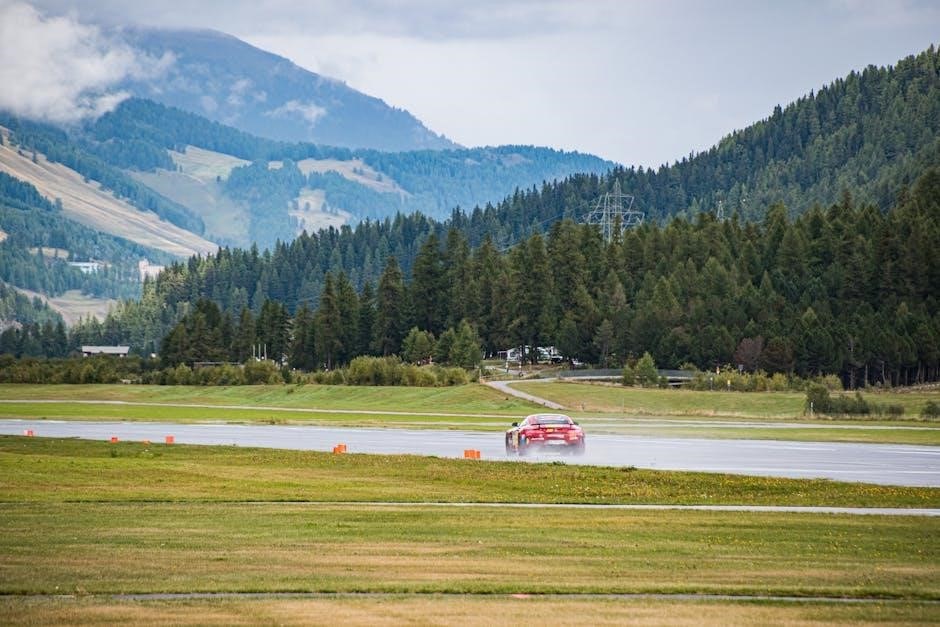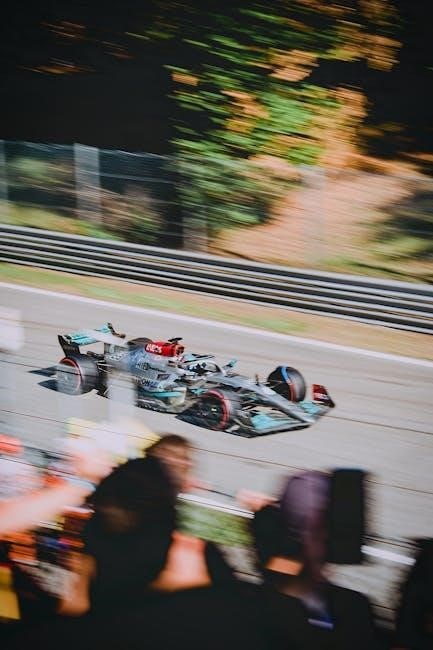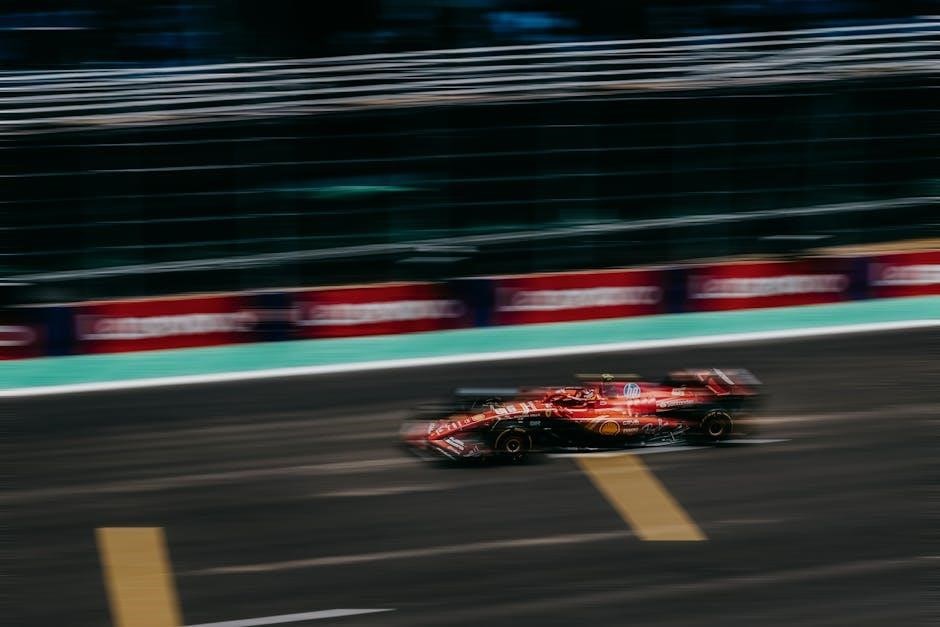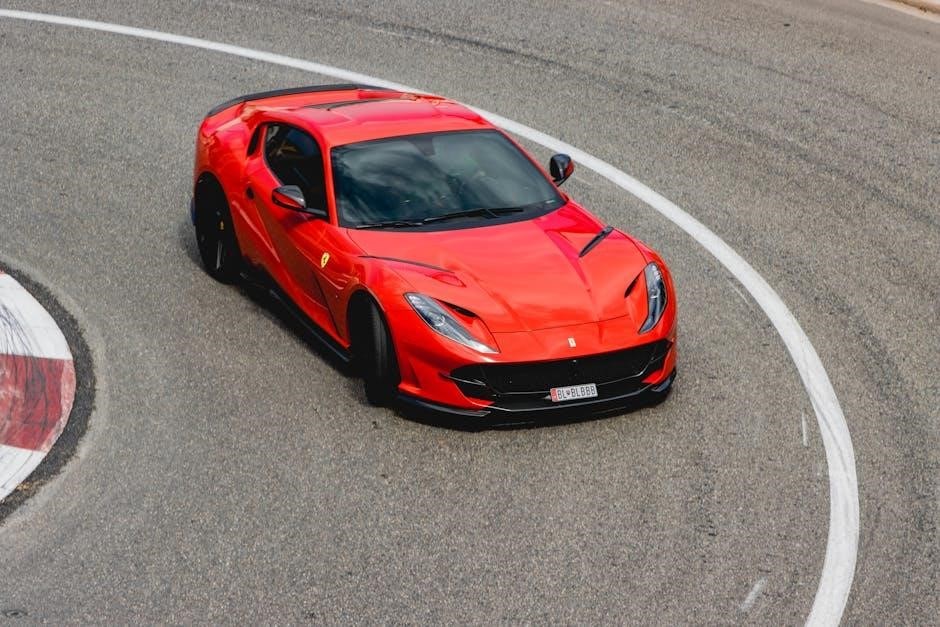Race car vehicle dynamics pdf provides detailed information on vehicle dynamics and its application in racing, including understeer and oversteer, using mathematical modeling and control systems effectively always online.
Overview of the Topic
Race car vehicle dynamics pdf is a comprehensive resource that covers the fundamental concepts of vehicle dynamics and their application in a racing environment, including the physical principles governing vehicle behavior and the engineering approaches used to analyze and improve performance. The topic of race car vehicle dynamics is complex and multifaceted, involving the study of the interactions between the vehicle, the driver, and the track. By understanding the dynamics of a race car, engineers and drivers can optimize the vehicle’s performance, improve handling and stability, and reduce the risk of accidents. The study of race car vehicle dynamics involves a range of disciplines, including physics, mathematics, and engineering, and requires a deep understanding of the underlying principles and mechanisms that govern vehicle behavior. This knowledge can be applied in a variety of contexts, from professional racing to amateur motorsports.
Importance of Vehicle Dynamics in Racing
The importance of vehicle dynamics in racing cannot be overstated, as it plays a crucial role in determining the performance and safety of the vehicle. A deep understanding of vehicle dynamics is essential for optimizing the handling and stability of a race car, allowing drivers to push the vehicle to its limits and achieve faster lap times. By studying vehicle dynamics, racing teams can identify areas for improvement and make data-driven decisions to enhance their vehicle’s performance. This knowledge can also be used to improve safety, by reducing the risk of accidents and minimizing the impact of collisions. Furthermore, a strong understanding of vehicle dynamics is essential for developing and implementing effective racing strategies, and for staying competitive in the highly technical and competitive world of professional motorsports, where every advantage counts and can be the difference between winning and losing.

Key Concepts in Race Car Vehicle Dynamics
Race car vehicle dynamics pdf covers fundamental principles and concepts effectively online always.
Understeer and Oversteer
Race car vehicle dynamics pdf discusses understeer and oversteer, two critical concepts in vehicle dynamics, and their impact on racing performance, including handling and stability, with detailed explanations and examples, using mathematical models to analyze and predict behavior, and providing insights into how to optimize vehicle setup and driver input to minimize understeer and oversteer, and improve overall racing performance, with a focus on the physical principles governing these phenomena, and engineering approaches to analyze dynamic behavior, including the use of computer simulations and data analysis, to help engineers and drivers understand and improve vehicle dynamics, and ultimately, racing performance, with the goal of achieving optimal handling and stability, and maximizing speed and efficiency, while minimizing the risk of accidents and injuries, by providing a comprehensive understanding of understeer and oversteer, and their role in race car vehicle dynamics.
Stability in Yawing and Response
Race car vehicle dynamics pdf examines stability in yawing and response, focusing on the ability of a vehicle to maintain directional stability and respond to driver input, with discussions on the factors influencing yaw stability, including vehicle design and setup, and the role of tires and suspension in maintaining stability, and providing insights into the dynamic behavior of vehicles during yawing and response, using mathematical models and simulations to analyze and predict vehicle behavior, and offering guidance on how to optimize vehicle setup and design to improve stability and response, with the goal of enhancing overall racing performance and safety, by understanding the complex interactions between vehicle design, driver input, and track conditions, and applying this knowledge to develop more stable and responsive vehicles, with improved handling and reduced risk of accidents, through the application of advanced engineering principles and techniques.

Mathematical Modeling of Race Car Dynamics
Mathematical models and simulations analyze vehicle dynamics using equations always online effectively.
Dynamics and Control Systems

Dynamics and control systems are crucial components of race car vehicle dynamics, enabling engineers to analyze and optimize vehicle performance.
Using mathematical models and simulations, engineers can design and develop control systems that improve vehicle stability and responsiveness.
The study of dynamics and control systems involves understanding the physical principles that govern vehicle motion, including forces, moments, and energy transfer.
By applying this knowledge, engineers can create sophisticated control systems that enhance vehicle performance, safety, and efficiency.
Moreover, the development of advanced control systems has become increasingly important in modern racing, where small improvements in performance can significantly impact competitiveness.
As a result, engineers and researchers continue to investigate new methods and technologies for improving dynamics and control systems in race cars, driving innovation and progress in the field of vehicle dynamics.
This ongoing research and development have significant implications for the future of racing and the automotive industry as a whole.
Vibrations and Mechanisms
Vibrations and mechanisms play a significant role in race car vehicle dynamics, affecting the overall performance and stability of the vehicle.
The study of vibrations involves understanding the dynamic behavior of components and systems, including suspension, engine, and drivetrain.
Mechanisms, such as gearboxes and differentials, must be designed to withstand the stresses and loads imposed by high-performance driving.
Engineers use advanced tools and techniques, including finite element analysis and modal testing, to analyze and optimize the vibration characteristics of race cars.
By minimizing unwanted vibrations and designing efficient mechanisms, engineers can improve the overall performance, safety, and reliability of the vehicle.
The analysis of vibrations and mechanisms is a critical aspect of race car design and development, requiring a deep understanding of the complex interactions between components and systems.
This knowledge enables engineers to create vehicles that are both fast and reliable, a crucial combination in the high-stakes world of professional racing.

Resources for Learning Race Car Vehicle Dynamics
Various online resources and textbooks provide detailed information on race car vehicle dynamics pdf for engineers and enthusiasts to learn effectively always online.
Reference Textbooks and Online Resources
There are several reference textbooks available that provide detailed information on race car vehicle dynamics, including pdf downloads and online resources. These textbooks cover various topics such as understeer, oversteer, and stability in yawing, and are written for engineers, students, and enthusiasts. Some popular online resources include websites and forums where users can discuss and share information on race car vehicle dynamics. Additionally, there are many online courses and tutorials available that teach the fundamentals of vehicle dynamics and its application in racing. These resources can be very helpful for those who want to learn about race car vehicle dynamics and improve their understanding of the subject. Many of these resources are available for free, while others require a subscription or a one-time payment. Overall, there are many reference textbooks and online resources available to help users learn about race car vehicle dynamics.
Useful Computer Programs for Vehicle Dynamics Work
Several computer programs are available to help with vehicle dynamics work, including those that can be used to analyze and simulate race car performance. These programs can be used to model and analyze various aspects of vehicle dynamics, such as suspension, steering, and braking systems. Some programs also allow users to create and test different vehicle configurations, making it easier to optimize performance. Many of these programs are available for download online, and some are even free to use. They can be a valuable tool for engineers, students, and enthusiasts who want to learn more about vehicle dynamics and improve their understanding of the subject; By using these programs, users can gain a better understanding of how different components interact and affect overall vehicle performance, and make more informed decisions when designing or modifying a vehicle. This can be very helpful for those working on race cars.

No Responses